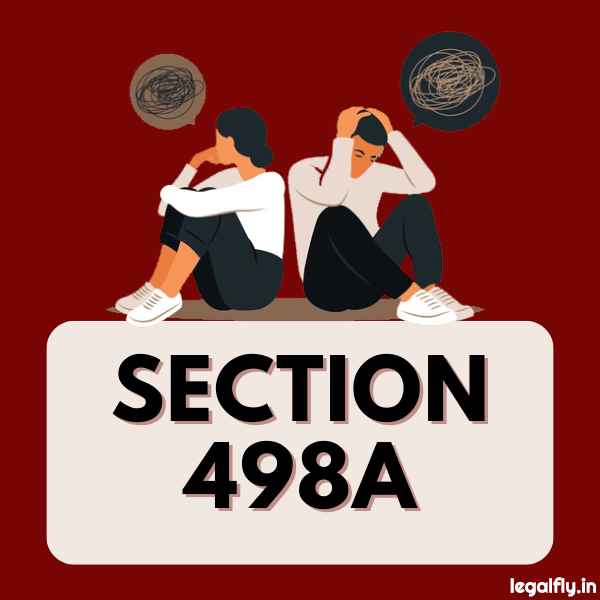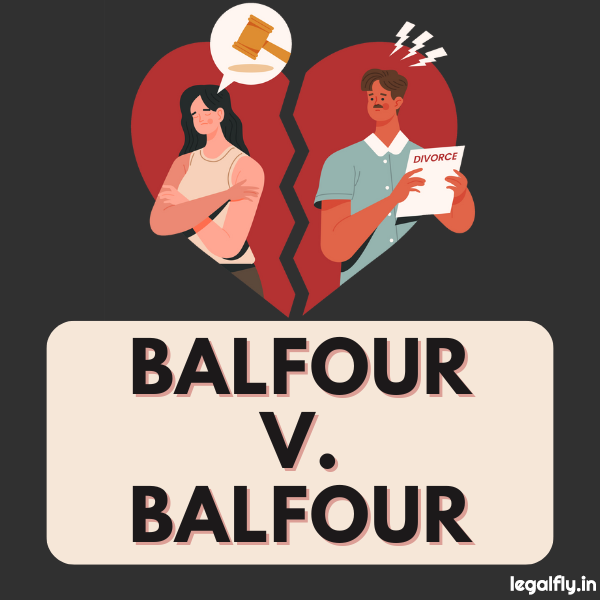Table of Contents
Introduction to Section 498A
Section 498A of the Indian Penal Code was introduced in 1983 as part of criminal law reforms to address the issue of cruelty and domestic violence against married women.
The law was enacted in response to growing public concerns over the rapidly increasing cases of dowry harassment and cruelty towards married women driven by demands for dowry. Before 1983, there were no specific legal provisions to deal with dowry-related cruelty, which was seen as a major factor behind crimes against women in marital homes.
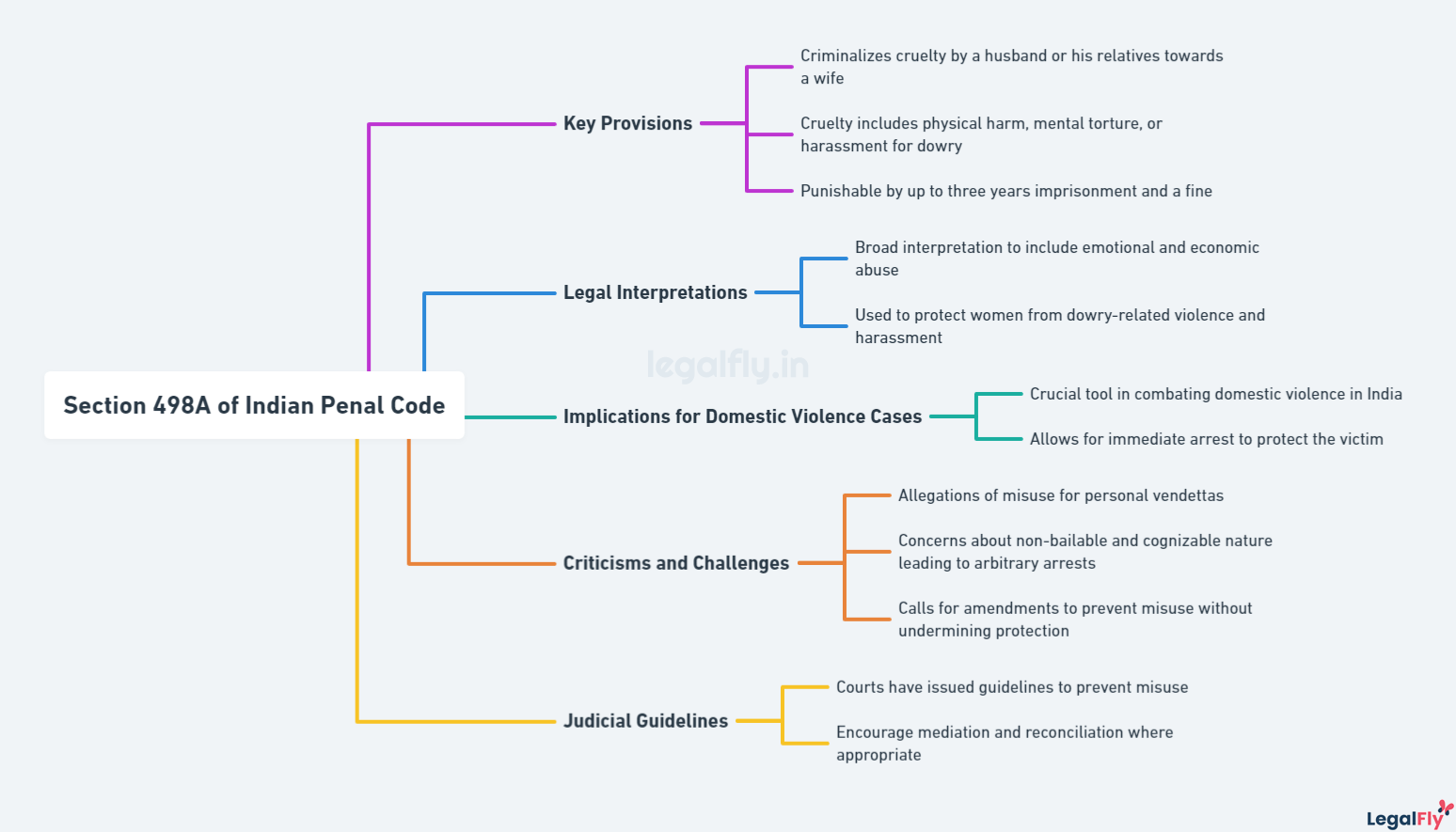
Section 498A defines the husband or his relatives subjecting a married woman to cruelty as a cognizable and non-bailable offence. It was introduced to protect the interests of married women and enable the prosecution of marital cruelty, which may drive victims to suicide or unlawful killing.
The enactment of Section 498A in 1983 was a landmark moment, as it was among the first laws aimed at providing married Indian women with legal recourse against domestic abuse and violence.
Overview of the Law
Section 498A of the Indian Penal Code defines cruelty by the husband or his relatives as a criminal offense. This section was introduced in 1983 to protect married women from cruelty and harassment by their husbands and in-laws.
The law defines cruelty as any willful conduct by the husband or his relatives that drives a woman to suicide or causes grave injury, both mental and physical, or poses a danger to her life. It gives a broad meaning to cruelty, including acts of harassment, punishment, torture, and demands for dowry.
Section 498A prescribes imprisonment of up to three years and fines for offenders. In cases where cruelty leads to the woman’s death, the husband or relative faces imprisonment between 7 years to life.
Common defences against accusations under Section 498A include claims of no direct acts of cruelty, allegations of misuse of the law, and lack of evidence to prove mental or physical cruelty. However, courts have held that even a single act of cruelty can constitute the offense under this section.
The Role of Section 498A in Protecting Women
Section 498A was enacted in 1983 to protect married women from cruelty and harassment by their husbands and in-laws. The main objectives of this law include:
- Providing legal protection to married women from domestic violence and abuse.
- Deterring marital cruelty by criminalizing psychological and physical abuse.
- Providing a civil law remedy for women facing abuse in marriages.
- Ensuring the constitutional right to equality for married women.
Since its enactment, Section 498A has had a significant impact on improving women’s rights and safety within marriages. The law empowered many women to speak up against domestic abuse and seek legal recourse. It has brought greater awareness regarding the marital rights of women. Many women have been able to escape abusive marriages due to Section 498A. The law acts as an important deterrent against domestic violence. It has also influenced social attitudes by establishing that abuse against married women is a punishable offense.
However, there are ongoing debates regarding the scope and implementation of this law. More work is still needed to fully achieve gender equality within Indian marriages. However, Section 498A remains a critical legal foundation for protecting the rights of married women in India.
Controversies and Criticisms
Some groups have criticized section 498A for being misused to harass husbands and their families. There have been allegations that women use this law to file false cases and extort money or force divorce settlements.
Several studies and surveys have claimed high rates of misuse, ranging from 15% to 98% (498 A: Misuse, abuse, or underused?). Critics argue that the law is biased against men and violates principles of natural justice. There have been demands for legal reforms to Section 498A to prevent misuse and protect the rights of the accused.
Some key concerns raised regarding Section 498A include:
- Making the offense non-bailable and cognizable, which allows arrests without investigation.
- Lack of penalty for false complaints.
- Definition of cruelty being too broad and subject to misinterpretation.
Several High Courts and Supreme Court judgments have also observed that Section 498A is being misused as a “tool for legal terrorism”. Based on these concerns, some have demanded making the offense bailable or compoundable.
However, women’s rights activists argue that allegations of misuse are exaggerated and the law is still needed to protect millions of women from cruelty and violence in marital homes. They oppose diluting Section 498A and demand strict enforcement along with penalties for false complaints. There are ongoing debates around reforms to the law to balance preventing misuse and protecting victims.
Key Legal Cases Involving Section 498A
Section 498A has been the subject of much litigation over the years. Here are 4 of the most important and influential court judgments relating to this law:
Sushil Kumar Sharma v. Union of India (2005)
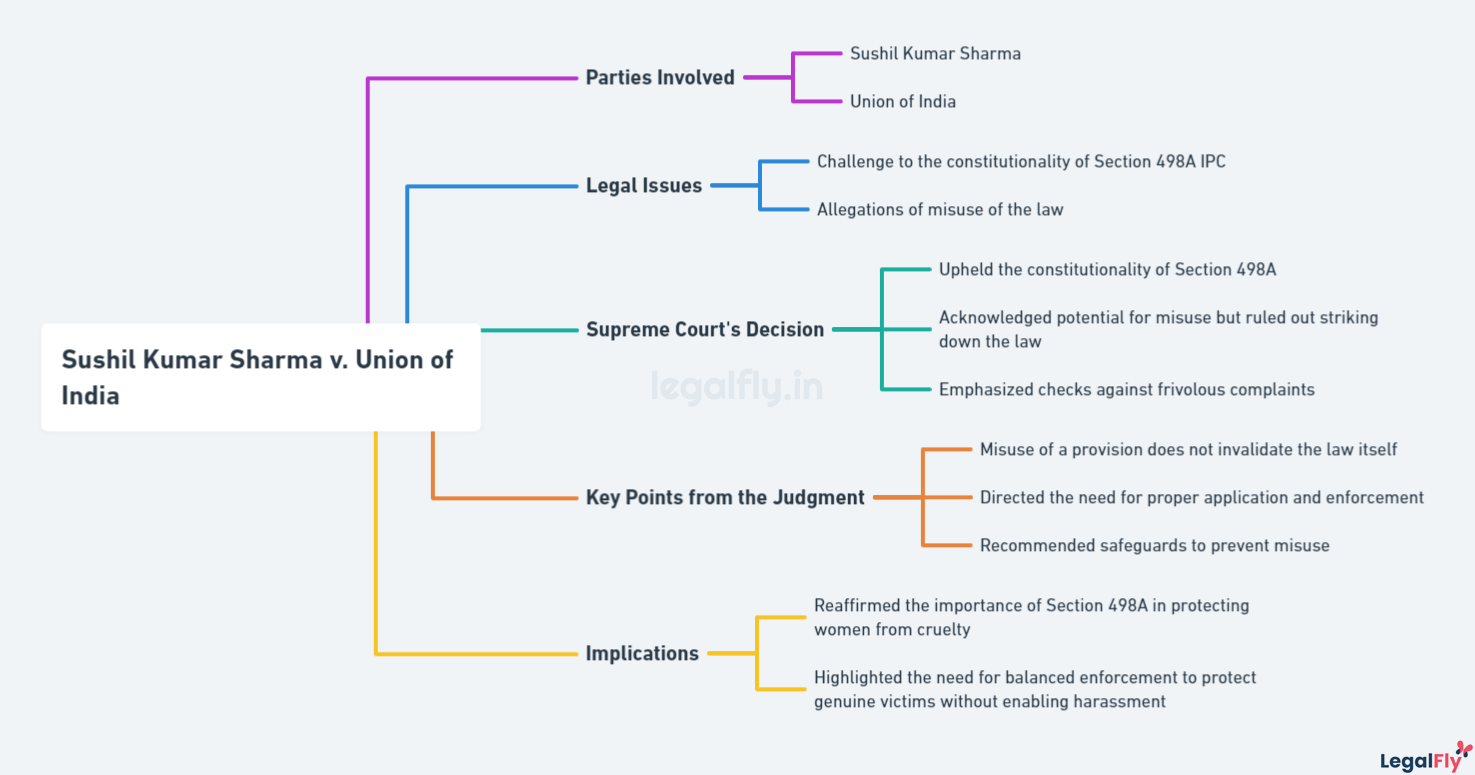
This Supreme Court case analyzed the constitutional validity of Section 498A and held it to be constitutionally valid. The court stated that the mere possibility of abuse does not invalidate a provision. However, it issued guidelines for the administration and application of the law to prevent abuse.
Arnesh Kumar v. State of Bihar (2014)
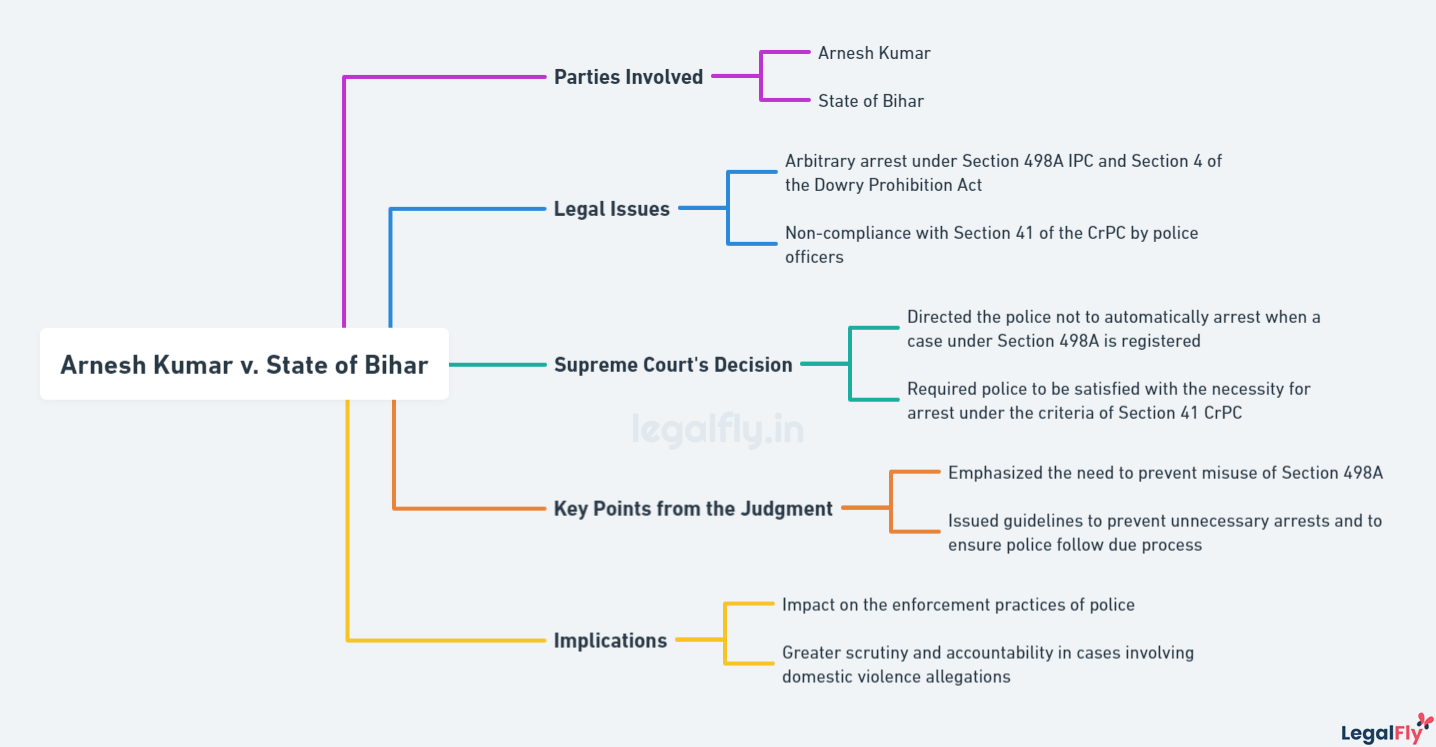
In this landmark case, the Supreme Court issued directives to prevent automatic arrests under Section 498A. It stated that police officers could not automatically arrest accused persons without assessing facts and must give notice before arrest. This judgment aimed to check misuse of the law.
Rajesh Sharma v. State of U.P. (2017)
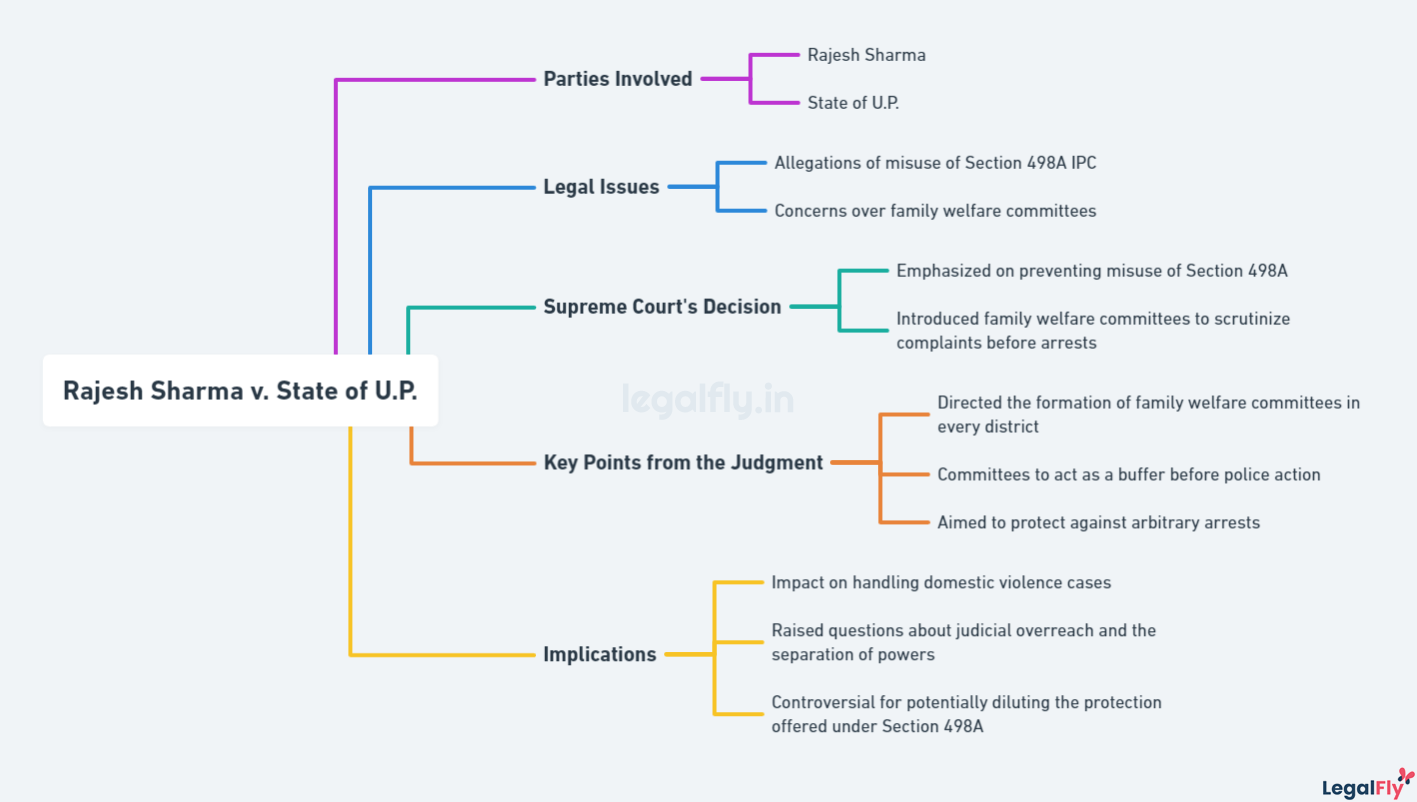
The Supreme Court issued guidelines for Family Welfare Committees to review Section 498A cases before arrests. It directed that bail should be granted in cases where the committee found no basis for the complaint. This was intended to prevent false cases.
Social Action Forum for Manav Adhikar v. Union of India
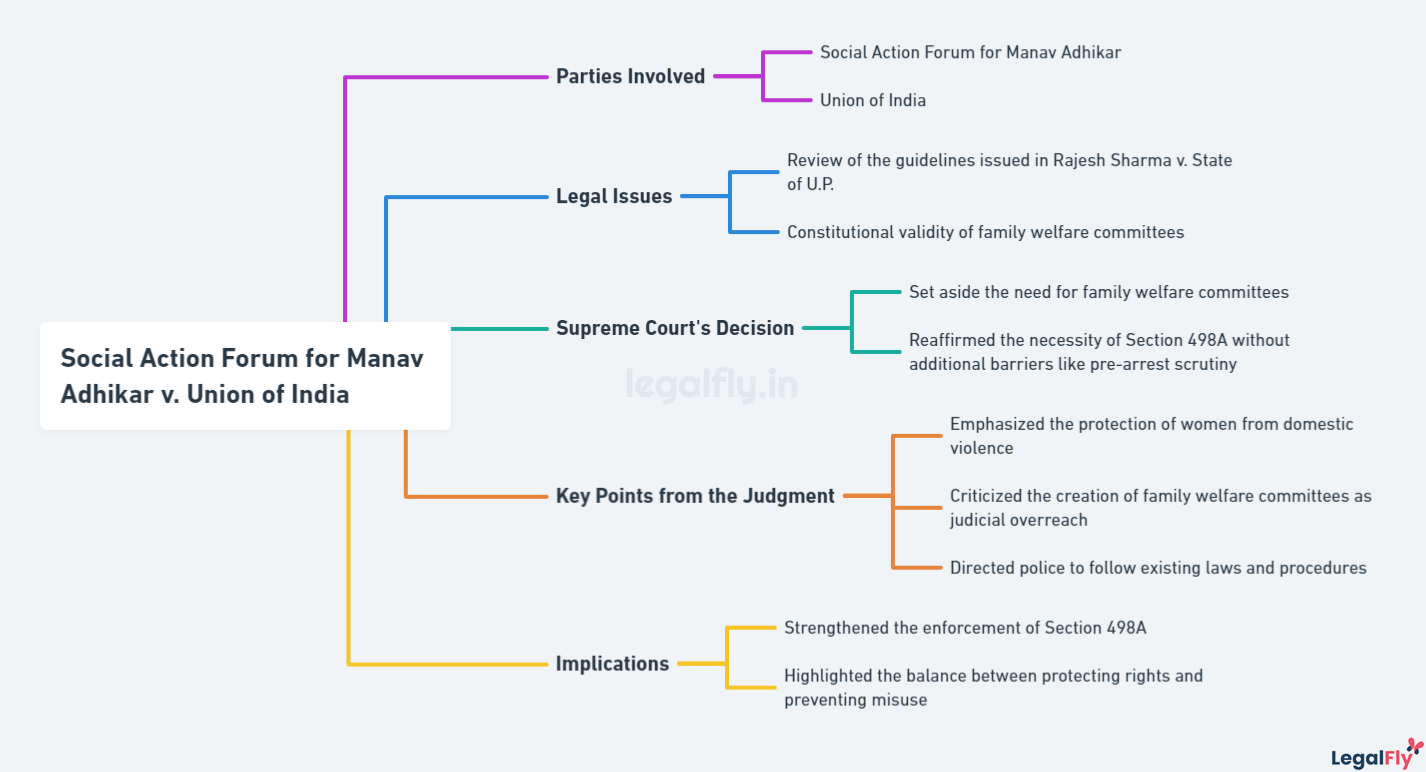
The Supreme Court struck down the Family Welfare Committee guidelines outlined in the Rajesh Sharma judgment. It held that these committees had no legal standing and amounted to unwarranted interference in the legal process.
Current Status and Future of Section 498A
Recent amendments and court rulings have impacted the application of Section 498A. In July 2017, the Supreme Court of India made the offense under Section 498A compoundable by making parties compromise and settle to restore the marital tie. The court aimed to safeguard the institution of marriage and avoid the irretrievable breakdown of marriage.
In September 2018, the Supreme Court directed that Family Welfare Committees must be set up in every district to scrutinize complaints under Section 498A before police can make arrests. The committee must submit a report to the police within a month, and no arrest can be made during this period. This was done to curb alleged misuse of the provision.
There are ongoing debates about further diluting the law due to concerns about legal provision misuse and abuse. Some critics argue that the law is often used to harass innocent in-laws and should be made bailable. However, women’s rights activists counter that any dilution will reduce protections for victims of cruelty. The future evolution of Section 498A remains a polarizing issue.
Statistics on Section 498A Enforcement and Outcomes
As per an analysis of NCRB data, the conviction rate under Section 498A has fallen from 21.9% in 2006 to 13% in 2018, even as the conviction rate for overall IPC crimes has risen in the same period. The pendency of 498A cases has also increased, with over 119,000 cases pending by the end of 2018.
A report by Partners for Law in Development analyzed data on the enforcement of 498A from 2009 to 2017. It was found that acquittal rates in 498A cases tried in court remained high, ranging from 46% to 58% in the period. However, the filing of FIRs under 498A substantially declined after the Supreme Court’s guidelines on misuse in 2014.
A study published in the Research Journal of Humanities and Social Sciences found that while over 100,000 cases are registered under 498A annually, only around 150 cases have reached the Supreme Court in appeals. This indicates gaps in access to justice for women filing complaints under 498A. More recent data is required to ascertain the full impact of legal changes on 498A enforcement.
Conclusion
Section 498A of the Indian Penal Code has had a complex history and impact since its enactment in 1983. The law was created to protect married women from cruelty and harassment by their husbands and in-laws. Over the decades, it has helped provide legal recourse for thousands of women facing domestic violence and abuse.
However, Section 498A has also been controversial, with allegations of misuse and claims that it is biased against men. Critics argue that some women exploit the law to harass their husbands’ families over petty disputes. Men’s rights groups have demanded that the law be diluted or made gender-neutral. Several amendments have been introduced to introduce safeguards against false complaints.
The Supreme Court and High Courts have delivered varied judgments on Section 498A over the years, upholding its validity in protecting women and placing checks and balances to prevent misuse. Landmark cases have helped shape the application and scope of the law. Recent rulings have mandated family welfare committees to scrutinize complaints to prevent false cases.
Overall, Section 498A remains a controversial but important legal provision to protect women from domestic violence, which remains a significant issue in India. The debate on balancing its benefits and potential for misuse will likely continue. More nuanced reforms may emerge to retain their core objective of preventing the harassment of innocent families. The law’s role in delivering justice to genuine victims and fairness to the accused will continue to evolve through judicial precedents and legislative amendments.

